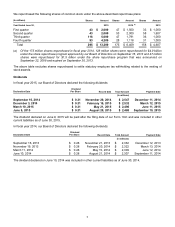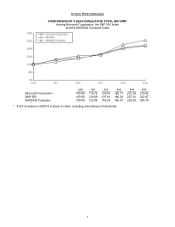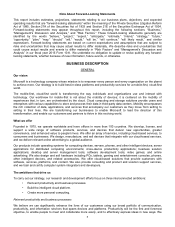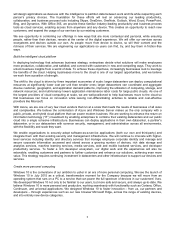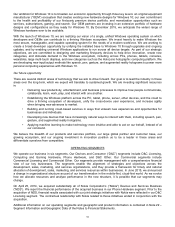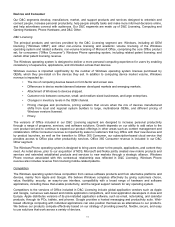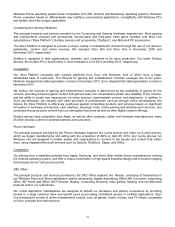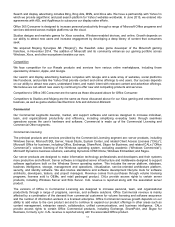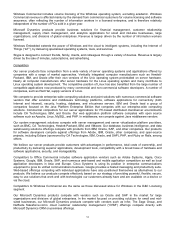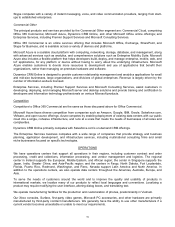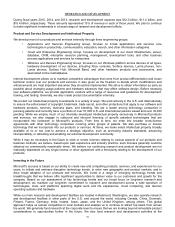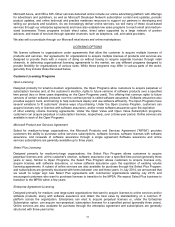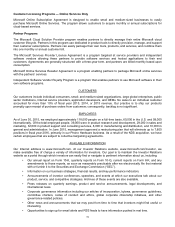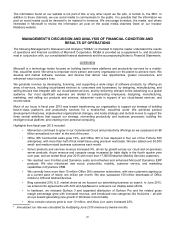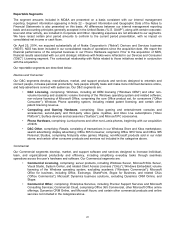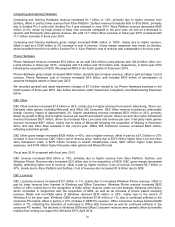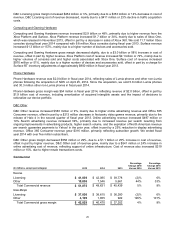Microsoft 2015 Annual Report Download - page 17
Download and view the complete annual report
Please find page 17 of the 2015 Microsoft annual report below. You can navigate through the pages in the report by either clicking on the pages listed below, or by using the keyword search tool below to find specific information within the annual report.
16
RESEARCH AND DEVELOPMENT
During fiscal years 2015, 2014, and 2013, research and development expense was $12.0 billion, $11.4 billion, and
$10.4 billion, respectively. These amounts represented 13% of revenue in each of those years. We plan to continue
to make significant investments in a broad range of research and development efforts.
Product and Service Development and Intellectual Property
We develop most of our products and services internally through three engineering groups.
• Applications and Services Engineering Group, focuses on broad applications and services core
technologies in productivity, communication, education, search, and other information categories.
• Cloud and Enterprise Engineering Group, focuses on development of our cloud infrastructure, server,
database, CRM, enterprise resource planning, management, development tools, and other business
process applications and services for enterprises.
• Windows and Devices Engineering Group, focuses on our Windows platform across devices of all types,
hardware development of our devices, including Xbox consoles, Surface devices, Lumia phones, non-
Lumia phones, Surface Hub, Microsoft Band, and other hardware products and accessories, and
associated online marketplaces.
Internal development allows us to maintain competitive advantages that come from product differentiation and closer
technical control over our products and services. It also gives us the freedom to decide which modifications and
enhancements are most important and when they should be implemented. We strive to obtain information as early as
possible about changing usage patterns and hardware advances that may affect software design. Before releasing
new software platforms, we provide application vendors with a range of resources and guidelines for development,
training, and testing. Generally, we also create product documentation internally.
We protect our intellectual property investments in a variety of ways. We work actively in the U.S. and internationally
to ensure the enforcement of copyright, trademark, trade secret, and other protections that apply to our software and
hardware products, services, business plans, and branding. We are a leader among technology companies in
pursuing patents and currently have a portfolio of over 57,000 U.S. and international patents issued and over 35,000
pending. While we employ much of our internally developed intellectual property exclusively in Microsoft products
and services, we also engage in outbound and inbound licensing of specific patented technologies that are
incorporated into licensees’ or Microsoft’s products. From time to time, we enter into broader cross-license
agreements with other technology companies covering entire groups of patents. We also purchase or license
technology that we incorporate into our products or services. At times, we make select intellectual property broadly
available at no or low cost to achieve a strategic objective, such as promoting industry standards, advancing
interoperability, or attracting and enabling our external development community.
While it may be necessary in the future to seek or renew licenses relating to various aspects of our products and
business methods, we believe, based upon past experience and industry practice, such licenses generally could be
obtained on commercially reasonable terms. We believe our continuing research and product development are not
materially dependent on any single license or other agreement with a third party relating to the development of our
products.
Investing in the Future
Microsoft’s success is based on our ability to create new and compelling products, services, and experiences for our
users, to initiate and embrace disruptive technology trends, to enter new geographic and product markets, and to
drive broad adoption of our products and services. We invest in a range of emerging technology trends and
breakthroughs that we believe offer significant opportunities to deliver value to our customers and growth for the
company. Based on our assessment of key technology trends and our broad focus on long-term research and
development, we maintain our long-term commitment to research and development across a wide spectrum of
technologies, tools, and platforms spanning digital work and life experiences, cloud computing, and devices
operating systems and hardware.
While our main research and development facilities are located in Redmond, Washington, we also operate research
and development facilities in other parts of the U.S. and around the world, including Canada, China, Denmark,
Finland, France, Germany, India, Ireland, Israel, Japan, and the United Kingdom, among others. This global
approach helps us remain competitive in local markets and enables us to continue to attract top talent from across
the world. We generally fund research at the corporate level to ensure that we are looking beyond immediate product
considerations to opportunities further in the future. We also fund research and development activities at the


